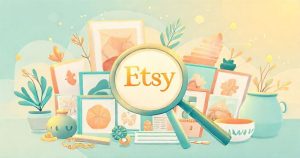Etsy stands as a unique global marketplace, a vibrant hub where creativity meets commerce, connecting millions of buyers with sellers offering distinctive handmade, vintage, and craft supply items. For aspiring entrepreneurs and established crafters alike, understanding the landscape of popular and profitable Etsy products is crucial for building a thriving online business. This guide delves into the specifics of what makes items sell, explores high-demand categories, and outlines strategic approaches to product selection and optimization on the platform.
Understanding the Etsy Marketplace: What Sells Best?
Success on Etsy is not merely about listing products; it involves a deep comprehension of consumer behavior and market trends within the platform’s unique ecosystem. Buyers flock to Etsy seeking originality, quality craftsmanship, and personalized touches that are often missing from mass-produced goods. Products that resonate most deeply are those that tell a story, solve a problem, or offer a unique aesthetic appeal, distinguishing them from competitors.
The most successful Etsy products often exhibit a blend of high quality, compelling visual presentation, and effective search engine optimization. Understanding your target audience’s needs and preferences is paramount. High-quality product photography, detailed descriptions, and transparent pricing also contribute significantly to a product’s appeal, guiding potential customers toward making a purchase decision. Consistently meeting customer expectations builds trust and repeat business.
Top-Selling Etsy Product Categories to Explore
Exploring various product categories on Etsy can reveal numerous opportunities for growth and profitability. Each category possesses its own unique market dynamics, target audience, and potential for customization. Identifying a niche within these broader categories can further refine your product strategy and help you stand out in a competitive environment.
Handmade Jewelry: Crafting Personal Adornments
Handmade jewelry consistently ranks among the most sought-after items on Etsy, driven by consumer demand for unique, artisanal pieces. This category encompasses a vast array of styles, from delicate minimalist necklaces and bold statement earrings to custom birthstone rings and personalized bracelets. Materials vary widely, including precious metals, semi-precious stones, resin, polymer clay, and even repurposed items, allowing for immense creative freedom.
Profitability in handmade jewelry often depends on material cost, complexity of design, and branding. For instance, a sterling silver pendant with a unique design might fetch $40-$80, while a custom-designed engagement ring could command hundreds or even thousands. Focusing on niche styles, sustainable materials, or specific aesthetics can help sellers carve out a distinct market presence within this ever-popular category.
Craft Supplies and Tools: Empowering Fellow Creators
Beyond finished products, Etsy thrives as a marketplace for craft supplies and tools, catering to a vast community of DIY enthusiasts and fellow artisans. This category includes everything from specialty yarns, unique fabric prints, and artisanal beads to digital patterns, toolkits, and raw materials for various crafts. Sellers can provide niche items that are difficult to find in conventional stores, adding significant value.
The demand for unique and high-quality craft supplies remains strong, offering a profitable avenue for sellers who understand the needs of other creators. For example, a bundle of rare vintage buttons might sell for $15-$25, while a meticulously designed digital embroidery pattern could range from $5-$15. Offering curated kits or exclusive material selections can further enhance a shop’s appeal and generate consistent sales.
Home Decor and Furnishings: Elevating Living Spaces
The home decor segment on Etsy is incredibly diverse, appealing to buyers looking to infuse their living spaces with personality and unique design elements. This includes items such as handmade pottery, personalized wall art, decorative pillows, unique planters, custom furniture pieces, and seasonal decorations. Many buyers seek items that reflect their personal style and cannot be found in mass-market retailers.
Customization plays a significant role in this category, with personalized signs, family portraits, and bespoke furniture pieces often commanding higher prices. A hand-painted abstract canvas could range from $50-$200, while a custom-built bookshelf might be priced at $300-$800, depending on size and materials. Focusing on current interior design trends or offering sustainable and eco-friendly options can attract a dedicated customer base.
Digital Products: Scalable Solutions for Modern Needs
Digital products represent a highly scalable and often very profitable category on Etsy due to their low overhead and instant delivery nature. This includes a wide range of downloadable items such as printable planners, unique SVG files for craft machines, social media templates, customizable invitations, digital art prints, and mockups for other sellers. Once created, these products can be sold an infinite number of times.
The profitability margins for digital products are exceptionally high, as there are no inventory or shipping costs. A digital planner template might sell for $10-$25, while a comprehensive bundle of social media templates could be $30-$70. Identifying specific needs within niches, such as wedding planning templates or small business branding kits, can lead to consistent passive income streams.
Apparel and Accessories: Fashion with a Personal Touch
Etsy’s apparel and accessories category caters to those seeking unique clothing, custom t-shirts, personalized tote bags, handmade scarves, and distinctive hats. Buyers appreciate the opportunity to purchase items that express individuality or serve as thoughtful gifts. Vintage clothing also holds a strong presence here, appealing to fashion enthusiasts looking for one-of-a-kind pieces.
Personalization is a key driver of sales within this category, whether through custom embroidery, printed designs, or bespoke sizing. A custom-designed t-shirt might sell for $25-$45, while a hand-knitted scarf could range from $30-$70. Focusing on high-quality materials, ethical production, or specific fashion subcultures can help sellers establish a loyal following and differentiate their offerings.
Strategic Product Research for Your Etsy Shop
Effective product research is the cornerstone of a successful Etsy shop. It involves more than simply looking at what’s currently popular; it requires an analytical approach to identify gaps in the market and anticipate future trends. Utilize Etsy’s search bar suggestions to discover long-tail keywords and see what buyers are actively searching for. Analyze competitors’ best-selling items, pricing strategies, and customer reviews to gain valuable insights.
Beyond Etsy, leveraging external trend analysis tools such as Google Trends or Pinterest Trends can provide broader insights into emerging consumer interests. Paying attention to seasonal demand is also vital; for instance, holiday-themed decorations or unique gift items experience surges in sales during specific times of the year. Thorough research helps in making informed decisions about product development and inventory management.
Maximizing Profitability with Etsy Products
Achieving strong profitability on Etsy requires careful consideration of pricing, costs, and operational efficiency. When setting prices, consider a combination of cost-plus pricing (materials + labor + overhead + profit margin), value-based pricing (what customers are willing to pay for your unique offering), and competitive pricing (how your prices compare to similar items). Clearly understanding your cost structure is essential.
Etsy fees, which include listing fees ($0.20 per item), transaction fees (6.5% of the total sale price), and payment processing fees (typically 3% + $0.25 per transaction), must be factored into your pricing strategy. Efficient sourcing of materials, streamlined production processes, and smart inventory management can significantly reduce costs. Scaling your business through batch production or offering digital products can further enhance profit margins and operational simplicity.
Etsy vs. Other Platforms: A Brief Comparison for Product Sellers
While Etsy excels as a niche marketplace for handmade, vintage, and craft supplies, sellers should understand how it compares to other e-commerce platforms. Etsy offers a built-in audience specifically seeking unique items, which can reduce initial marketing efforts. However, sellers have less control over branding and website design compared to platforms like Shopify, where you build your own storefront.
Amazon Handmade provides a larger customer base but often comes with higher competition for certain product types and different fee structures. Shopify offers complete customization and branding control but requires the seller to drive all traffic to their store. Choosing the right platform depends on your business goals, product type, desired level of control, and marketing budget. Etsy remains ideal for those who fit its specialized market focus.
Charting Your Course: Future Success with Etsy Products
Building a successful venture on Etsy is a journey that combines passion, creativity, and strategic business acumen. By focusing on high-demand, unique Etsy products, conducting thorough market research, and implementing smart pricing and operational strategies, sellers can cultivate a thriving online presence. The platform offers an unparalleled opportunity to connect with a global audience seeking authenticity and craftsmanship. Continuous learning, adaptation to market shifts, and a commitment to quality will pave the way for sustained growth and profitability in your Etsy shop.





